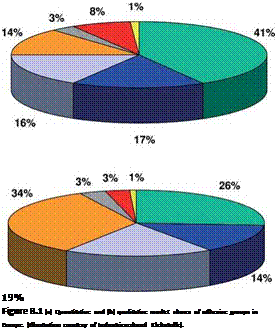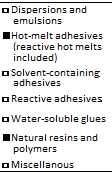Examples for the successful use of adhesive bonding technologies can be found in many fields of application. When choosing the best adhesive for a specific application, the limits of resistance of an adhesive joint to static, cyclic or impact load must be considered. The expectation in service life depends on the service conditions in terms of aging and detrimental environmental effects.
Since not only the strength capacity and the material properties of adhesives, but also their characteristic processing requirements, play an important role in evaluating the suitability for a certain application, adhesives have been classified according to their processing conditions and their chemical nature (see Chapters 4 and 5 and Figure 8.1). The following types of adhesive can be distinguished:
• physically setting adhesives
• reactive adhesives setting by mixing of two components, irradiation, moisture, absence of oxygen, heating, etc.
Due to a growing ecological awareness, the level of toxicity of different types of adhesive has gained significant importance. For example, in physically setting adhesives this has led to a reduction in the use of solvents (see Chapter 4).
In structural bonding, reactive adhesives provide the highest level of strength, temperature resistance and durability.
Once specific types of adhesives have been established, for example in the paper and packaging industry, or the woodworking or construction industries, they may be used for decades without any significant modification; this in turn leads to standardized, trade-specific adhesive product lines.
Today, the packaging and the building and construction industry represent the largest turnover in adhesives, while the strongest growth in adhesive demand is seen in automotive and commercial vehicle construction, in electronics, and in medical engineering in general.
In the following sections we will discuss the state ofthe art ofadhesive bonding in different trades, on the basis of representative applications.
 |
 |
 4 ноября, 2015
4 ноября, 2015  Pokraskin
Pokraskin  Опубликовано в рубрике
Опубликовано в рубрике 